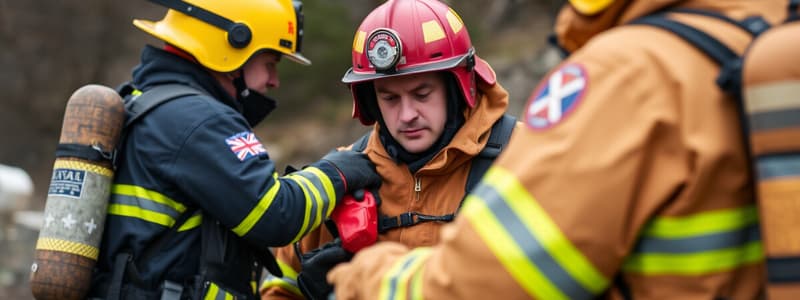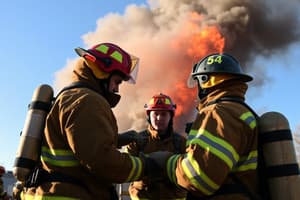Podcast
Questions and Answers
What is the primary purpose of the Rapid Intervention/Two-in Two-Out policy?
What is the primary purpose of the Rapid Intervention/Two-in Two-Out policy?
- To manage financial records
- To enhance public relations
- To establish a Rapid Intervention Team (RIT) (correct)
- To streamline fire response operations
To which personnel does the Rapid Intervention/Two-in Two-Out policy apply?
To which personnel does the Rapid Intervention/Two-in Two-Out policy apply?
- Only Incident Commanders
- Only EMS officers
- Only firefighters
- All personnel of the Barnstable Fire Districts (correct)
How many firefighters make up a Rapid Intervention Team (RIT)?
How many firefighters make up a Rapid Intervention Team (RIT)?
- Two
- Five
- Four (correct)
- Three
When should the Incident Commander establish a RIT?
When should the Incident Commander establish a RIT?
Who has the authority to change the assignment of a RIT designated company once dispatched?
Who has the authority to change the assignment of a RIT designated company once dispatched?
What should potential RITs monitor while en route to the scene?
What should potential RITs monitor while en route to the scene?
What should RITs bring with them upon arrival at the incident scene?
What should RITs bring with them upon arrival at the incident scene?
What is included in the basic RIT tools?
What is included in the basic RIT tools?
What specialized equipment should a RIT have available for operations?
What specialized equipment should a RIT have available for operations?
What crucial information should the RIT Officer receive upon arriving at the scene?
What crucial information should the RIT Officer receive upon arriving at the scene?
What is the essential task that the RIT must perform continuously upon arrival?
What is the essential task that the RIT must perform continuously upon arrival?
What is a critical part of the RIT's scene size up procedure?
What is a critical part of the RIT's scene size up procedure?
What additional tasks can the RIT undertake in enhancing firefighter safety?
What additional tasks can the RIT undertake in enhancing firefighter safety?
When is the RIT obligated to activate their team?
When is the RIT obligated to activate their team?
From where should the RIT deploy when activated?
From where should the RIT deploy when activated?
What is the essential function of a RIT during an incident?
What is the essential function of a RIT during an incident?
What communication devices does the RIT utilize for monitoring?
What communication devices does the RIT utilize for monitoring?
What type of equipment should the RIT keep ready at the scene?
What type of equipment should the RIT keep ready at the scene?
Study Notes
Rapid Intervention/Two-in Two-Out Policy Overview
- Purpose is to establish a Rapid Intervention Team (RIT) for firefighter safety and rescue.
- Policy applies to all personnel within the Barnstable Fire Districts, ensuring a unified approach.
Rapid Intervention Team (RIT) Details
- A RIT consists of four firefighters, tasked with providing immediate assistance to distressed personnel.
- The Incident Commander must establish a RIT when operating in IDLH (Immediately Dangerous to Life or Health) environments or high-risk incidents.
RIT Authority and Communication
- Only the Incident Commander (IC) from the requesting community can change the dispatch assignment of a RIT.
- RITs must monitor the fire ground radio channel(s) while en route to the incident to stay informed.
Equipment and Tools for RIT
- Upon arrival, RITs should carry full Personal Protective Equipment (PPE) and basic tools necessary for rescues.
- Basic RIT tools include:
- 200’ Kevlar RIT Search Rope
- Thermal Imaging Camera (TIC) with spare battery
- Set of irons
- SCBA RIT Pack with spare PASS device
- Portable radios and flashlights
- Stokes basket
Additional Equipment Requirements
- RIT may require extra tools such as a 24’ Ground Ladder, specialized rescue equipment, and a dedicated hose line for emergencies.
RIT Responsibilities and Operations
- The RIT Officer should receive an Incident Action Plan (IAP) and details on the interior crews and resources from the IC upon arrival.
- Continuous size-up assessments, including a complete 360-degree walk around, are crucial to identify hazards and ensure firefighter safety.
Activation and Deployment of RIT
- Activation of the RIT occurs when a firefighter is reported lost, trapped, or injured.
- When activated, RIT should deploy from the suspected last location of firefighters in distress to improve response efficiency.
Communication and Reporting
- RIT leaders must develop clear expectations with the Incident Commander for effective mission execution.
- RIT must report to the Incident Commander upon arrival for coordination of activities and current situation updates.
Primary Function of RIT
- The primary function is to provide rapid assistance or rescue for firefighters in distress, ensuring their safety in emergency situations.
Monitoring and Staging
- RIT should use portable radios for ongoing communication with the IC.
- Staging of equipment should take place at the primary entry point for efficient access during rescue operations; this includes basic tools and equipment.
Post-Briefing Procedures
- After the briefing from the IC, the RIT Officer must report to the designated staging area and prepare for deployment without delay.
Summary of Key Tasks
- Core tasks of the RIT focus on scene assessment, equipment assembly, monitoring communications, and ensuring egress for trapped firefighters.
- Ongoing monitoring, maintaining contact with the IC, and readiness for rapid response are integral to RIT operations.
Studying That Suits You
Use AI to generate personalized quizzes and flashcards to suit your learning preferences.
Description
This quiz covers the essential policies and procedures related to the Rapid Intervention Team (RIT) in firefighting operations. It outlines the team's structure, authority, communication protocols, and the equipment necessary for effective rescue operations. Understanding this information is crucial for firefighter safety and operational efficiency.




